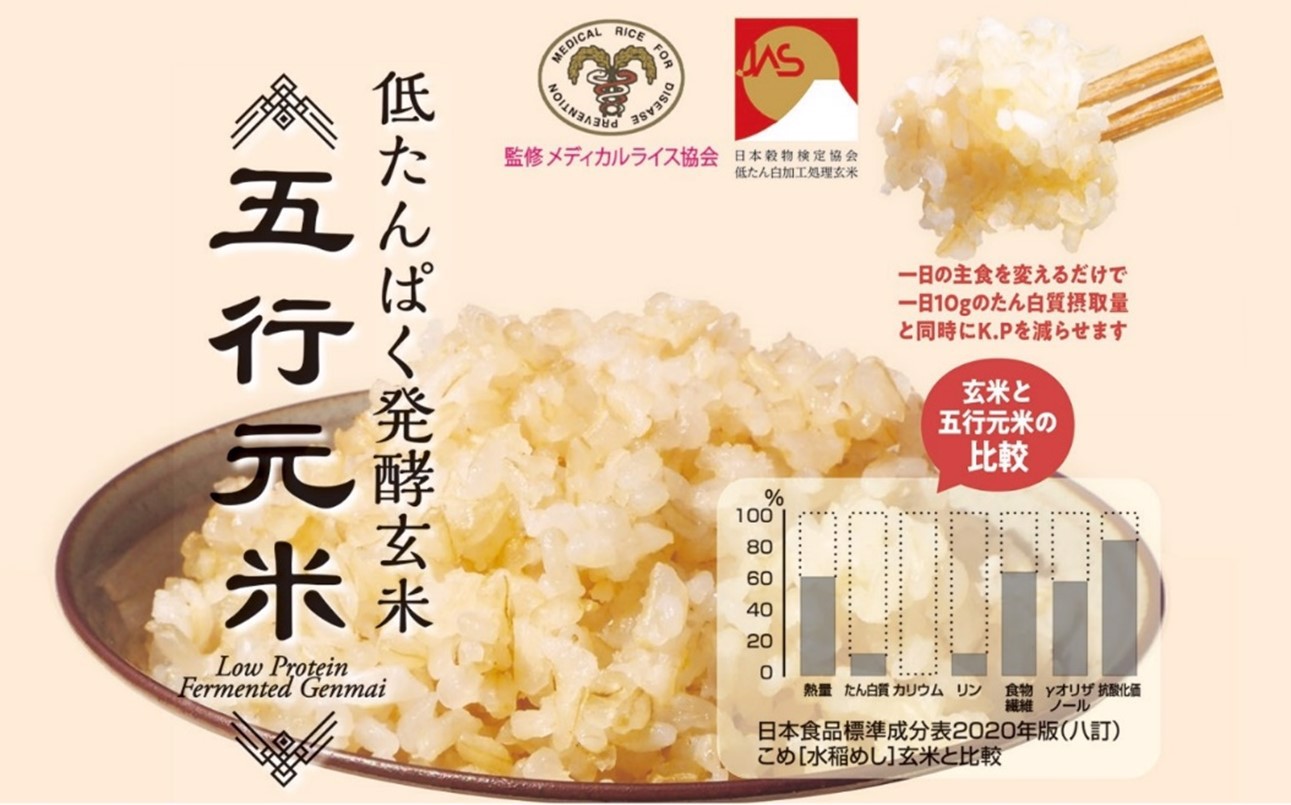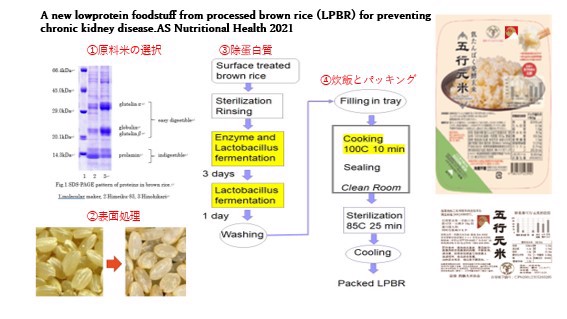FKII newsletter vol.8(Date 11/15/2024)
◆Contents◆
1. Project to develop and produce low protein fermented brown rice
----------------------------------------------------
1. Project to develop and produce low protein fermented brown rice
----------------------------------------------------

CKD (chronic kidney disease) is on the rise worldwide, most recently due to the aging population and complications from diabetes and hypertension. Low-protein diets are the most effective intervention to prevent the progression of CKD, but conventional low-protein white rice does not taste good and is not supported by patients.
Our R&D platform members have successfully removed rice protein from brown rice by using a specific combination of proteolytic enzyme solution and Lactobacillus plantaris. In addition to the residual carbohydrates (energy source), the low protein rice characteristics of low protein, low potassium, and low phosphorus, and the presence of dietary fiber, γ-oryzanol, and antioxidant activity are characteristics of the low-protein brown rice (Gogyo-genmai) .
This processed low-protein brown rice has been certified by the Ministry of Agriculture, Forestry and Fisheries of Japan (JAS0027) for the product and process.

In order for low-protein brown rice (Gogyo-genmai) to be marketed and used by patients, it must first be accepted by the medical community, which requires evidence. The level of proof includes clinical trials, literature, epidemiological studies, and personal opinions, all of which must be theoretically constructed without conflicts. Only if the medical community accepts them will it be possible to spread diet therapy.
The data was collected through an intervention study in Japan and overseas (China and Indonesia). Especially in China, where the number of CDK patients is estimated to be over 100 million and the number of hemodialysis patients is over 800,000.
The study design was integrated as much as possible so that the clinical trials in foreign countries could be conducted on the same basis as the one in Japan.
It is difficult to manage energy intake and protein restriction at the same time in dietary therapy for CKD patients. We conducted intervention trials in patients at various stages of CKD to generate evidence for dietary therapy. We asked patients to only replace their main meal with low-protein brown rice and to eat without severely restricting protein in side dishes. This study demonstrated a decrease in urinary toxins and proteinuria, which are increased in CKD patients.
The 2nd International Workshop on Dietary Therapy for Chronic Kidney Disease was held in Okinawa to share information on the ongoing intervention trials in Japan and overseas and brought together experts from 12 countries to discuss how diet therapy that corrects the entero-renal axis can reduce uremic toxin production and decrease renal function. All participants share the importance of reducing uremic toxin production and preserving renal function using an entero-nephrotoxin-corrected diet.
The Chinese demand was so great that a Chinese export base was set up in Talian to distribute packaged rice for clinical trials. The water treatment of Fukushima issue has had a political impact, but we have set up a system to transport the product domestically from this base. The export was approved after submitting relevant documents such as a radiation inspection certificate, quarantine certificate, certificate of hygiene, certificate of origin, and certificate of composition.
In an intervention study conducted in Nanjing, (1) 63% of patients who were introduced to whole foods responded, "I hope it will work" and 29% responded "I don't know, I'll try it anyway". Other responses included "I don't want to eat something I don't know". (2)Three of the recruited patients pronounced "I have a good friend who has been eating brown rice for years and his illness has been cured and his body has become strong. (3)About 76% of the respondents said that it is easy to eat compared to other brands of food, while the rest said that they were not sure because they were eating it for the first time.(4) The percentage of respondents who answered "yes" to the question of whether or not they continue to eat whole foods as a staple diet was 89%. (5) If the product is effective in the clinical trial, 28% of the respondents answered that they would definitely purchase it, 19% said they would decide after consulting with their family, 37% said it would be difficult to continue purchasing the product by self-payment, and the rest said they would not purchase it due to its high price.(6) Some of the candidates, who are affluent patients, said that if the benefits were really evident, a high-class package and box would be enough, and that customers and their partners would be happy to receive a gift of something good for their health, which is currently unique in China.
In Japan, the benefits of low-protein brown rice have been promoted through the Japanese Society of Anti-Aging Medicine, the Japanese Society of Renal Nutrition and Metabolism, and the Japanese Society of Clinical Nutrition, and have gained the support of clinical doctors, nutritionists, and public health nurses. Low-protein brown rice can be used for patients with renal insufficiency at any stage of life and may be the first clear target for "medical rice" and has attracted many inquiries from overseas. We intend to continue working to promote it.
----------------------------------------------------
Please visit the website of Field for knowledge Integration and Innovation (FKII) The Council of Industry-Academia-Government Collaboration.
https://www.knowledge.maff.go.jp/en/fkii.html
If you would like to inquire, publish your projects or unsubscribe from this e-mail newsletter, please contact us here.
Secretariat of Council of Industry-Academia-Government Collaboration
PwC Consulting LLC
E-mail:jp_cons_fkii_jimu@pwc.com
PLEASE DO NOT REPLY to noreply@fkii-jimu.com
----------------------------------------------------